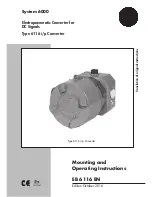
14
Time remaining
The SmartShunt estimates how long the battery can support the present load. This is the “time-to-go” readout
and is the actual time left until the battery is discharged to the set “discharge floor”. The discharge floor is by
default set at 50%. For the discharge floor setting see paragraph 7.1.3: “Discharge floor”.
If the load is fluctuating heavily, it is best not to rely on this reading too much, as it is a momentary readout and
should be used as a guideline only. We recommend the use of the state of charge readout for accurate battery
monitoring.
If the “Time remaining” indicates three dashes: “---” this means that the SmartShunt is in an unsynchronised
state. This occurs when the SmartShunt has just been installed or after the SmartShunt has been left unpowered
and is powered up again. For more information, see paragraph 5.3: “Synchronising the SmartShunt”.
Input
This is the state of the Aux input. Depending on how the Aux port has been set up, you will see one of these
options:
•
Starter battery voltage:
This shows the voltage of a second battery.
•
Battery temperature:
This shows the battery temperature of the main battery when the optional temperature
sensor is used.
•
Midpoint voltage deviation:
This shows the deviation in a percentage of the main voltage of the battery
bank top section compared to the voltage of the bottom section. For more information on this feature see
chapter 9: “Midpoint voltage monitoring”.
5.3 Synchronising the SmartShunt
For a reliable readout, the state of charge, as displayed by the battery monitor, must be synchronised regularly
with the true state of charge of the battery. This to prevent drift of the “State of charge” value over time. A
synchronisation will reset the state of charge of the battery to 100%.
5.3.1
Automatic synchronisation
Synchronisation is an automatic process and will occur when the battery has been fully charged. The SmartShunt
will look at a few parameters to ascertain that the battery has been fully charged. It will consider the battery to be
fully charged when the voltage has reached a certain value and the current has dropped below a certain value for
a certain amount of time.
These parameters are called:
•
Charged voltage
- the float voltage of battery charger.
•
Tail current
- a percentage of the battery capacity.
•
Charged detection time
- the time in minutes.
As soon as these 3 parameters have been met, the SmartShunt will set the state of charge value to 100%, thus
synchronising the state of charge.
Example:
In case of a 12V battery, the SmartShunt will reset the battery’s state of charge to 100% when all these
parameters have been met:
•
The voltage exceeds 13.2V,
•
the charge current is less than 4.0% of the total battery capacity (e.g. 8A for a 200Ah battery) and,
•
3 minutes have passed while both the voltage and current conditions are met.
If the SmartShunt does not perform a regular synchronisation, the state of charge value will start to drift over
time. This is due to the small inaccuracies of the SmartShunt and because of the estimation of the Peukert
exponent. Once a battery has been fully charged, and the charger has gone to float stage, the battery is full and
the SmartShunt will automatically synchronise by setting the state of charge value to 100%.
Содержание SmartShunt 1000A
Страница 1: ...EN Manual SmartShunt 500A 1000A 2000A...















































